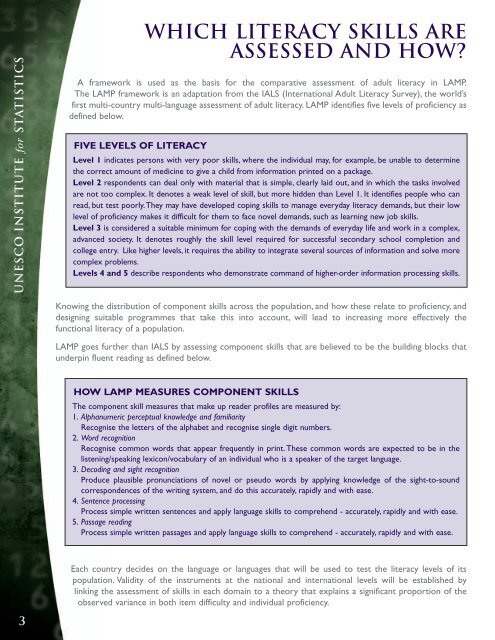Literacy Assessment and Monitoring Programme (LAMP) - Local ...
Literacy Assessment and Monitoring Programme (LAMP) - Local ...
Literacy Assessment and Monitoring Programme (LAMP) - Local ...
Create successful ePaper yourself
Turn your PDF publications into a flip-book with our unique Google optimized e-Paper software.
3UNESCO INSTITUTE for STATISTICS<br />
Which literacy skills are<br />
assessed <strong>and</strong> how?<br />
A framework is used as the basis for the comparative assessment of adult literacy in <strong>LAMP</strong>.<br />
The <strong>LAMP</strong> framework is an adaptation from the IALS (International Adult <strong>Literacy</strong> Survey), the world’s<br />
first multi-country multi-language assessment of adult literacy. <strong>LAMP</strong> identifies five levels of proficiency as<br />
defined below.<br />
FIVE LEVELS OF LITERACY<br />
Level 1 indicates persons with very poor skills, where the individual may, for example, be unable to determine<br />
the correct amount of medicine to give a child from information printed on a package.<br />
Level 2 respondents can deal only with material that is simple, clearly laid out, <strong>and</strong> in which the tasks involved<br />
are not too complex. It denotes a weak level of skill, but more hidden than Level 1. It identifies people who can<br />
read, but test poorly.They may have developed coping skills to manage everyday literacy dem<strong>and</strong>s, but their low<br />
level of proficiency makes it difficult for them to face novel dem<strong>and</strong>s, such as learning new job skills.<br />
Level 3 is considered a suitable minimum for coping with the dem<strong>and</strong>s of everyday life <strong>and</strong> work in a complex,<br />
advanced society. It denotes roughly the skill level required for successful secondary school completion <strong>and</strong><br />
college entry. Like higher levels, it requires the ability to integrate several sources of information <strong>and</strong> solve more<br />
complex problems.<br />
Levels 4 <strong>and</strong> 5 describe respondents who demonstrate comm<strong>and</strong> of higher-order information processing skills.<br />
Knowing the distribution of component skills across the population, <strong>and</strong> how these relate to proficiency, <strong>and</strong><br />
designing suitable programmes that take this into account, will lead to increasing more effectively the<br />
functional literacy of a population.<br />
<strong>LAMP</strong> goes further than IALS by assessing component skills that are believed to be the building blocks that<br />
underpin fluent reading as defined below.<br />
HOW <strong>LAMP</strong> MEASURES COMPONENT SKILLS<br />
The component skill measures that make up reader profiles are measured by:<br />
1. Alphanumeric perceptual knowledge <strong>and</strong> familiarity<br />
Recognise the letters of the alphabet <strong>and</strong> recognise single digit numbers.<br />
2. Word recognition<br />
Recognise common words that appear frequently in print. These common words are expected to be in the<br />
listening/speaking lexicon/vocabulary of an individual who is a speaker of the target language.<br />
3. Decoding <strong>and</strong> sight recognition<br />
Produce plausible pronunciations of novel or pseudo words by applying knowledge of the sight-to-sound<br />
correspondences of the writing system, <strong>and</strong> do this accurately, rapidly <strong>and</strong> with ease.<br />
4. Sentence processing<br />
Process simple written sentences <strong>and</strong> apply language skills to comprehend - accurately, rapidly <strong>and</strong> with ease.<br />
5. Passage reading<br />
Process simple written passages <strong>and</strong> apply language skills to comprehend - accurately, rapidly <strong>and</strong> with ease.<br />
Each country decides on the language or languages that will be used to test the literacy levels of its<br />
population. Validity of the instruments at the national <strong>and</strong> international levels will be established by<br />
linking the assessment of skills in each domain to a theory that explains a significant proportion of the<br />
observed variance in both item difficulty <strong>and</strong> individual proficiency.

















